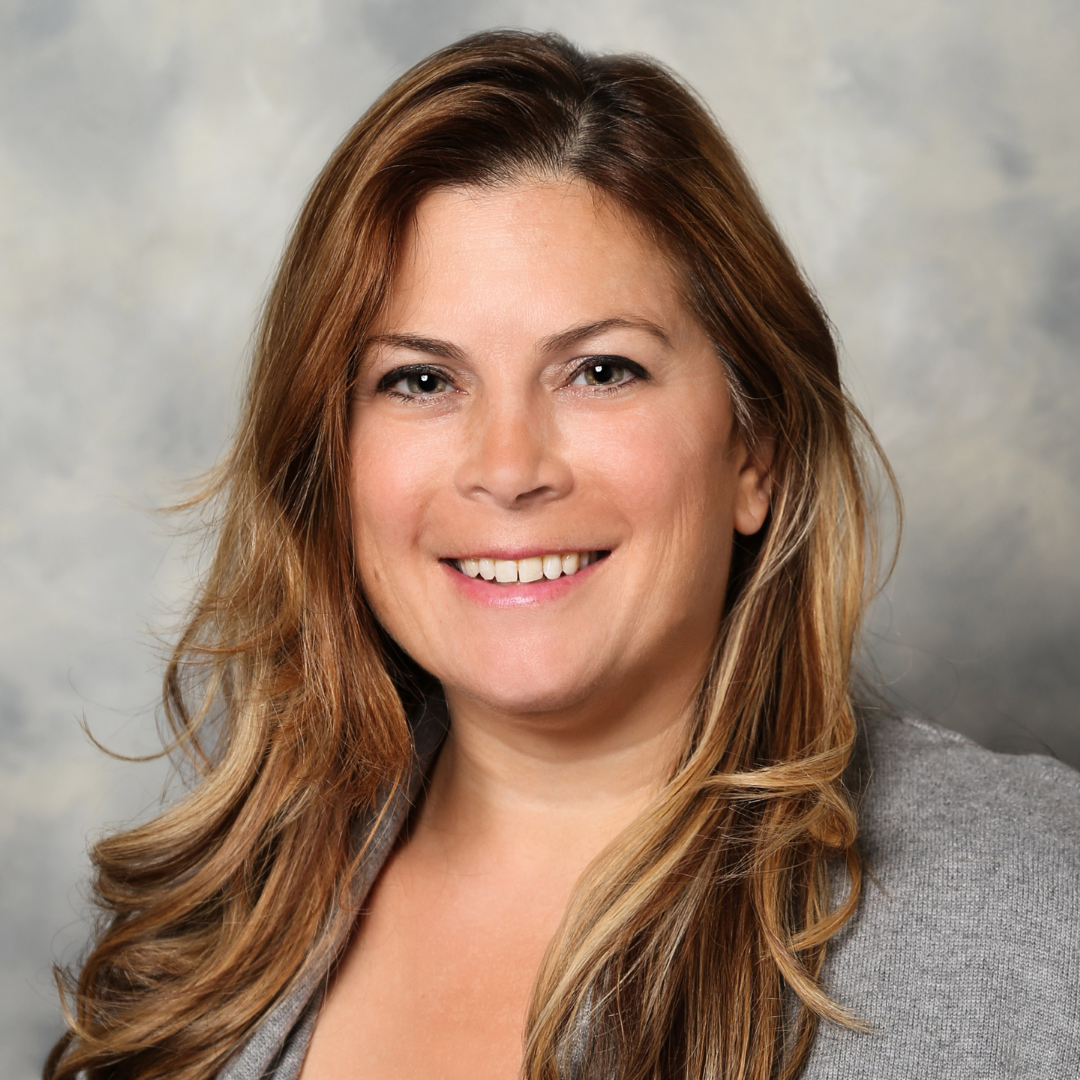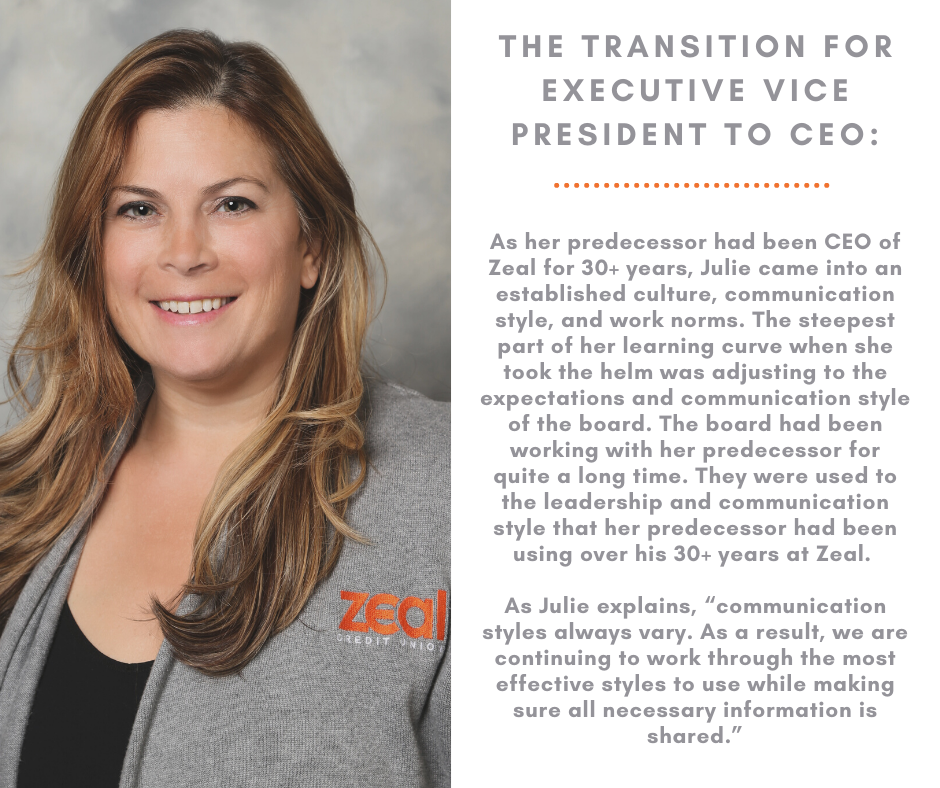


At Newcleus Credit Union Advisors, we work with various C-Suite executives to ensure their credit union achieves success. Each of the CEOs we work with has had a unique experience in becoming the leader they are today. This month, we’re highlighting Julie Kreinbring from Zeal Credit Union. With 25 years of industry experience, she became the fourth Zeal Credit Union CEO in 2019. Here, Julie provides great insight into what her transition to CEO was like, as well as a few tips for aspiring CEOs.
The Transition from Executive Vice President to CEO.
Change is never easy for employees, board members, and other parties within the credit union industry. As her predecessor had been CEO of Zeal for 30+ years, Julie came into an established culture, communication style, and work norms. The steepest part of her learning curve when she took the helm was adjusting to the expectations and communication style of the board. The board had been working with her predecessor for quite a long time. They were used to the leadership and communication style that her predecessor had been using over his 30+ years at Zeal.
industry. As her predecessor had been CEO of Zeal for 30+ years, Julie came into an established culture, communication style, and work norms. The steepest part of her learning curve when she took the helm was adjusting to the expectations and communication style of the board. The board had been working with her predecessor for quite a long time. They were used to the leadership and communication style that her predecessor had been using over his 30+ years at Zeal.
As Julie explains, “communication styles always vary. As a result, we are continuing to work through the most effective styles to use while making sure all necessary information is shared.”
Navigating those changes is still a work in progress for Julie, who has been the CEO for over a year and a half now. She shared “it’s important to ask clarifying questions?” Or ‘how do you like this method of presentation?’ really asking: ‘what do you expect as a board and what are your expectations of me?’”
As a leader, Julie takes a more transparent approach to communication. She is extremely open and honest with her executive team about the vision and direction for Zeal. By being open and honest, she enables her team to collaborate on how to best realize that vision.
The most profound part of the transition to CEO for Julie personally, was becoming the ultimate decision-maker for the credit union. In her prior role as Executive Vice President, she was making a lot of decisions, however she had one more person to review things before final decisions were made. It was a very transformative personal realization that “every single person at Zeal, their livelihood, depends on how well we are going to run this organization.”
The shift from a day-to-day operational focus to a strategy-focused credit union.
One important aspect of Julie’s leadership style is the strategy-focused mindset she brings to the table. For her team at Zeal, the transition from a more operationally-focused culture to a strategy-focused structure took a bit of adjustment. This initiative really took off when she hired an outside firm to support her efforts through executive coaching for key team members and consultation regarding strategy.
One of the biggest challenges Julie faced at the beginning of this migration was gaining buy-in from the entire Zeal team. Specifically, she had to change a cultural perception of the executive team being unwilling to change. In a previous role at another credit union, she helped transform the culture of that organization in 2-3 years, but with Zeal’s size and history, she felt it would likely take more than double that time. Therefore, Julie had to adjust her own expectations, with the realization that some of the cultural changes she wanted to carry through would need more time to truly take root.
At the beginning of last year, her leadership team created a well-thought-out strategy and operational business plan to guide them through these changes. Of course, once COVID hit, that plan needed adjustment. With changes in staffing due to the pandemic and personnel needs, Julie needed a better understanding of how the credit union was operating on every level.
“Due to COVID, we had need for personnel in many of our departments. For instance, we needed help in the call center so I said ‘hey, I’ve done this before, let me hop on and start helping members.’ This was a huge blessing as I was able to see first-hand how the credit union was running operationally versus what I thought was happening from the leadership perspective. I saw very quickly that we were still using a number of inefficient processes that were supposed to have been modified a while prior. During this effort, I recognized our team members truly care about the members and taking care of their needs. However, at the time, we didn’t have the necessary transparency to allow our employees to question a process and be heard. In many cases, they were just following steps because that was the order listed on a checklist rather than asking ‘why are we doing this?’ and ‘is there a way to do it better?’”
This episode led Julie to realize that the vision of having all levels of the credit union working toward process improvement would require further action. The mandate to question “the way we’ve always done things” in order to improve credit union operations didn’t appear to be getting down to the front-lines. Julie had to double-down on her communication efforts and focus her message at all levels throughout the organization versus simply cascading the message down through employee ranks. This pivot also changed the value employees placed on giving their feedback, now seeing that the CU was actively seeking everyone’s focus on improving the organization and its operations. “I think the example from the process change within our call center, led our people to recognize ‘hey, if the CEO is going to ask ‘why are we doing this,’ and we’ve been saying the same thing all along, let’s use our voices to raise those ideas.’”
Now Julie’s team has expanded the channels available for team members to give their insight. The credit union uses quarterly feedback sessions, to help the employees share their feedback with the executive team. Additionally, the credit union also has an anonymous avenue for feedback for employees that are challenged by sharing their thoughts in a more formal setting.
As a result of the anonymous surveys, Julie received key feedback. The feedback shared that the employee truly felt that Julie was attempting to make changes for the positive, but that the rest of the executive team didn’t appear to be on the same page. This sparked an introspective conversation within the leadership team and led to increased communication across the entire group. Employees need to feel comfortable sharing observations like this if implemented changes are going to work. Additionally, Julie shared that as the strategy is formulated, team members need to be able to open and honestly give their insight and input, however once the overall direction for the organization is chosen, each leader in the organization has to own delivery of the message and the pivot in the credit union’s culture.
Julie told us one of her tips is to make sure she is out in the credit union as much as possible. “You cannot ‘lead’ solely from your office, your team has to see you ‘walking the talk’ and you have to seek insight continuously.” As she makes her way throughout the credit union, she makes a point of being where the action is. One of her key roles is continuously asking questions of employees and encouraging her team to voice their questions. With the heavy emphasis on finding added insight from team members and empowering her team to voice those questions and insights, she has already seen beneficial changes occur within the CU.
Julie has already driven significant change at Zeal Credit Union. Taking the reins of the organization just before the global pandemic has been a crucible like no other. As Zeal continues to grow, Julie will soon be among the 14% of female credit union CEOs who lead a credit union of over $1 billion in assets.
